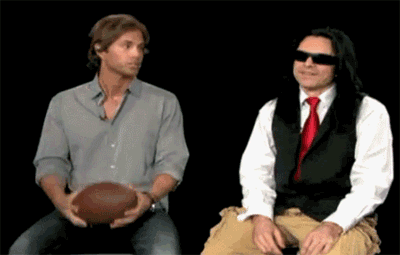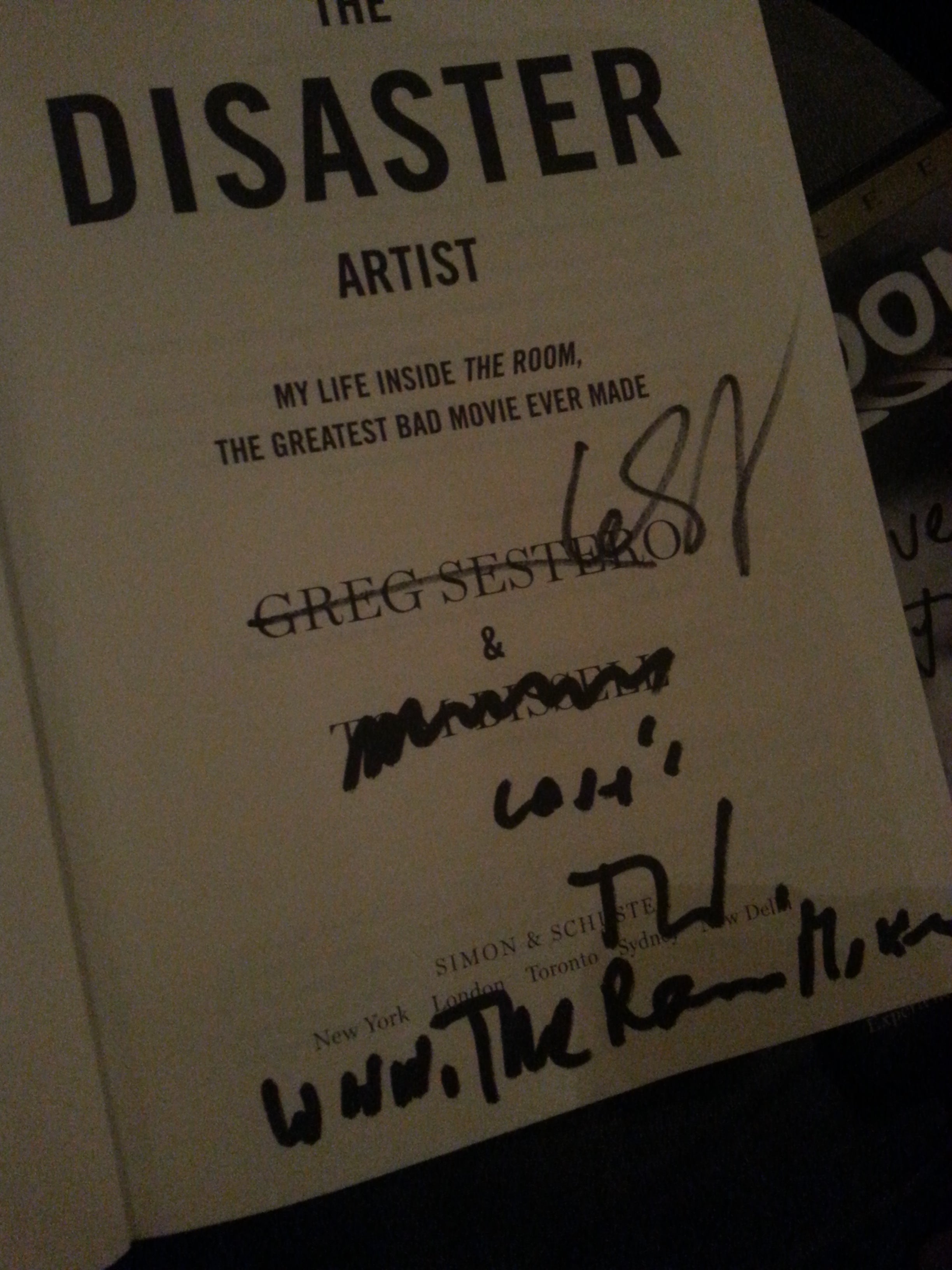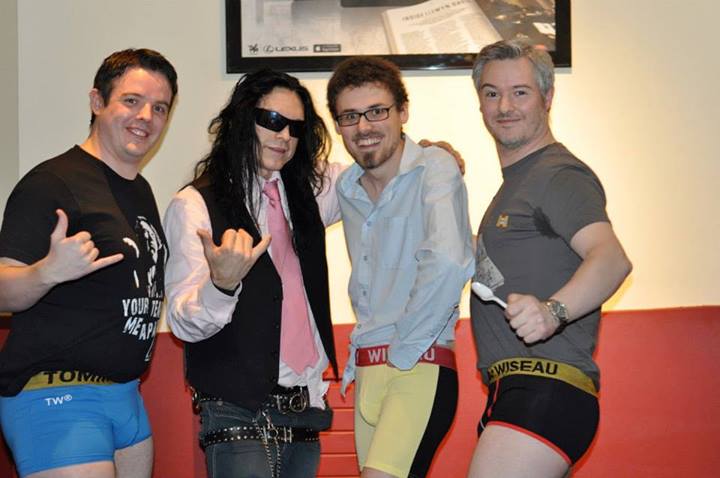Really, the description “the Citizen Kane of bad movies” doesn’t do justice to the full experience of watching The Room.
A masterpiece of disjointed storytelling, bad dialogue, unfocused camerawork and poor editing, it’s barely even comparable to other infamously terrible movies like Troll 2 or the works of Ed Wood. And yet somehow, The Room has become more than the sum of its parts.
Released in 2003, The Room seemed destined for obscurity. Written, produced and funded by an unknown director and starring a cast of nobodies, it might well have sunk without trace were it not for the fast-spreading rumors that it truly was the worst film ever made. Hardly anyone showed up to its original two-week run in a single movie theatre in Los Angeles, but over a decade after its release, its creator Tommy Wiseau is now a celebrity among connoisseurs of “so bad it’s good” entertainment.
Wiseau is The Room. Unrelentingly eccentric and often incomprehensible to outsiders, he’s a figure of fascination among the movie’s ever-growing fanbase. His air of mystery is twofold: first of all, how could anyone manage to create a movie like The Room in the first place? Secondly, who is he? Nobody knows how Tommy Wiseau raised the $6 million required to film The Room. Nobody knows where he was born, although it was probably somewhere in Eastern Europe. Nobody even knows how old he is. The only person who seems to have an insider view of Wiseau’s life is his friend and former co-star Greg Sestero.

GIF via fuckyeah-theroom / Tumblr
Sestero met Wiseau in 1998, at an acting class in San Francisco. Sestero was an up-and-coming young actor and model, and saw in Wiseau what many people see in The Room today: a kind of childlike enthusiasm, coupled with a personality that seemed to operate at odds with the rest of humanity. Wiseau may not have been exactly charismatic, but he certainly was fascinating, and Sestero found himself playing a serious role in the four-year process of creating The Room.
It ended up being such a uniquely bizarre experience that, with help from journalist Tom Bissell, Sestero published a memoir about it last year: a hilarious and occasionally disturbing book that was recently optioned by James Franco and Seth Rogen’s production company. In a review of Sestero’s book, The Disaster Artist, Franco described Wiseau as “part vampire, part Hollywood dreamer, part gangster, part Ed Wood, and super lonely.”
The success of The Disaster Artist spawned a screening tour that Sestero and Wiseau are taking across the U.S. and U.K. I meet up with them at Edinburgh’s Cameo Picturehouse, an indie cinema stalwart that seems slightly unprepared for the long queue of excited fans who show up half an hour before the doors open for a pre-screening meet-and-greet.
The first thing I have to ask is what Wiseau thought of the book. Although Sestero says in The Disaster Artist that he is Wiseau’s “best friend” (a term that Wiseau seems to love, both in his movie and in real life), it’s a long-suffering kind of affection, borne of acting as Wiseau’s handler during the lengthy process of filming and then publicising The Room. His portrayal of Wiseau is about as positive as it could be, showing him to be simultaneously likeable and slightly unhinged. In real life, Wiseau is surprisingly friendly and nonthreatening, and grudgingly rates the book as “50 percent” accurate.
But which 50 percent?
“I think Greg overall did a very good job,” Wiseau said. “I guess the way he’s spinning, that’s his opinion. You know, I cannot tell him what to do. He’s my best friend basically, but it is what it is. They did not inform me about it. Nobody actually checked with me, some of the facts and stuff.”
Despite living in the U.S. for (probably) decades, Wiseau still speaks in the same broken English as when Sestero met him in 1998. His idiosyncratic mode of speech will be familiar to anyone who has tried to parse The Room, in which most of the dialogue is spoken in what Sestero refers to as “Tommy-ese”.
When I ask Wiseau what he thinks of the upcoming movie adaptation of The Disaster Artist, he says, “I think James Franco can play me, sure. They say they might involve me a little, but I’m not 100 percent what will transpire at this time.”
I notice later that when he signs copies of Sestero’s book for fans, he takes care to scribble out the co-author’s name every time.

Photo by the author
Even after 15 years of on-and-off partnership, Wiseau and Sestero do not look like two people who belong in the same room together, never mind an international signing tour. Sestero has Disney Prince hair and is wearing a replica of Ryan Gosling’s Drive jacket. Wiseau, on the other hand, looks exactly like how any fan of The Room would expect him to look. He’s wearing wraparound sunglasses (indoors, after sunset), a pink tie, and about three superfluous belts. He doesn’t seem to have aged since he filmed The Room more than 10 years ago.
One of Tommy Wiseau’s many eccentricities is his desire to stay absolutely silent on the subject of his age. Sestero’s book characterises this as an obsession with youth, but some fans jokingly theorise that he’s a vampire. His vaguely Eastern European accent and long, straggly dyed-black hair add a lot to the image, but the most convincing detail is the fact that there is a photo of him that appears to be from the 1970s and shows almost the same Tommy Wiseau we see before us.
At the Q&A before the screening, an overly confident fan asks Wiseau his birthday. Wiseau gives the month and day easily enough, but the year is obviously a no-go area. Truth be told, I didn’t even bother asking him myself. Barring some kind of criminal investigation, no one is ever going to find out Tommy Wiseau’s real name, never mind his date of birth.
Photo by Grace Kane
Sestero explains that The Disaster Artist movie will be directed by Franco and produced by Seth Rogen, and James Franco’s Instagram indicates that it will star the Franco brothers. Whatever happens, it’s sure to be a hit among The Room’s fanatical audience, most of whom have seen the film multiple times.
Sestero’s next acting project is a Kickstarter-funded movie named Dude Bro Party Massacre, a horror comedy starring Patton Oswalt and Peter Stormare.
When I ask about his next project, Wiseau says that he’s working on a sitcom called The Neighbors, which will apparently be happening in “September, October.”
Does that mean that he’s working on it at the moment?
“No, I’m going to finish.”
So the release date for The Neighbors is actually this fall? He says yes, although he adds that they haven’t actually cast any actors yet.
In fact, The Neighbors is something that’s been on the back-burner for a while, as a couple of minutes from a pilot episode have been on YouTube for years. Happily for Wiseau fans, that footage is just as oddball as The Room, indicating that Wiseau isn’t a one-hit wonder. If The Neighbors ever surfaces as a full-length series, it’s likely to be just as mesmerising as Wiseau’s first work. However, I get the impression that Wiseau doesn’t have much motivation to go ahead with new projects like this. Right now, the ongoing success of The Room is still allowing him to travel the world and hang out with adoring fans, even if that adoration is mostly of the ironic hipster persuasion.
Among The Room’s fans are several celebrities, including Alec Baldwin, Paul Rudd, Will Arnett, and Kristen Bell (who conspired with Veronica Mars creator Rob Thomas to include some Room references in Veronica Mars itself). It’s not inconceivable that should it ever see the light of day, Wiseau’s next project could be packed with celebrity cameos. So, would he consider casting any famous actors, if they were interested?
“To me, that’s secondary,” Wiseau said. “My idea behind entertainment is what people actually contribute to the project as an individual. If you study the acting, I think everyone in [The Room] did a good job. If you have, let’s say, an unlimited budget for a certain project, a film or a sitcom or whatever, so you can shop around for better actors… who’s better? I cannot define ‘better’.”
So you’d say that the actors in The Room are of the same caliber as a big star?
“I think yes. I personally think some of the actors from The Room put themself down by thinking they’re not good enough to continue work, for example.”
Do you think that’s the effect of the reputation of The Room?
“I don’t see that, not at all. This is my take: I’m an entertainer, and I like to entertain people. I want people laugh. I always say, you can laugh, you can cry, you can express yourself. But please don’t hurt your children.” Another Tommy-ism. “If you watch the person who plays Lisa…. are you familiar with The Room?”
I reassure him that yes, I have indeed watched The Room. Over the course of the interview, he also asks me if I’ve heard of James Dean, and if I know what Blu Ray is. Tommy Wiseau doesn’t think much of his audience.
“If you analyze Lisa, what she offer as a person? What does she offer to the project? What she offer to the audience? What triggers when people talk about this particular actor? You know what I’m saying?”
I don’t really know what he’s saying.
“What I’m saying is, if you put something on the table that is beneficial, it’s much more important than if someone has big money.” He turns to Sestero. “What do you think about it, does actor do a good job?”
Sestero chimes in with a tactful answer. “Well, you know, if it’s your first project, you’ve got a lot of room to grow. If everyone quit after their first movie then we wouldn’t have –”
At which point Wiseau interrupts to talk about how he replaced the actors and crew four times while filming The Room, a topic we see from a rather different perspective in The Disaster Artist.
In many ways, the book makes Wiseau sound like the archetype of a maniacal auteur, firing cameramen and actors left and right if they don’t agree with his vision. One standout detail is that he had a private bathroom built in the middle of the set at unnecessary expense, but neglected to have a door installed. So in amongst firing half the cast and crew and occasionally failing to pay his employees, Wiseau would use his own personal bathroom in front of everyone, with nothing but a curtain for privacy.
But speaking to me, Wiseau just said, “So many people, they did not work out well. I had a sort of vision, and otherwise we would not be sitting in this beautiful place here.”
In his memoir, Sestero describes showing an early edit of The Room to his family. At that point no one except Wiseau really thought it would ever be finished, never mind screened in actual cinemas. But as soon as Sestero’s family saw that video, they were hooked. The Room was clearly an unsurpassable masterpiece of car crash viewing, and they were the patient zero for the cult effect that would later spread across the world.
“I think it was towards 2010,” Sestero said, when I ask when they began to realize that The Room was such a huge phenomenon. “There was this theatre in New York, and like 1,200 people showed up. It just kept spreading because everybody wants to show it to their friends and experience it.”
“People don’t realise that we started the midnight screening because of an issue with fire marshal,” Wiseau said. “Some misleading newspaper said that after two weeks running, we shut down. Because we want The Room to show two weeks to be qualified for the Academy Awards. They just could not run more because of the agreement we have.”
It’s true that Wiseau paid for his movie to screen for two weeks so it would be eligible for an Oscar, but he also deviates somewhat from the reality of The Room’s rise to fame.
Although The Room did gain a small following towards the end of its original run, this was mostly thanks to a young filmmaker named Michael Rousselet, who saw the movie by accident and was immediately hooked. He and his friends became the core of early Room fandom, meaning that the movie’s final screening had an audience of around a hundred people. Still, not exactly a vast success. A significant portion of the film’s $6 million budget was spent on publicity, but the first one-off midnight screening didn’t happen until 2004, a result of the film’s growing reputation as the worst movie ever made.
The cult of The Room spread across the U.S. via word of mouth, and crossed the Atlantic some time in the late 2000s thanks to online piracy. Wiseau tells me that his next idea is to take The Room on tour to Russia and China. With subtitles.
The big question is to what extent Wiseau acknowledges his own reputation. In the past he’s given the impression that he feels that his movie is misunderstood, but he seems to have mellowed with age. There’s no way that he actually agrees with the many thousands of fans who think The Room is the worst movie ever made, but he has developed a pretty healthy philosophy regarding the people who view his work with this combination of love and blatant mockery.
“We don’t force people to see the movie, but if they enjoy it, they come back. I am an entertainer. I have no comment except I want people to enjoy themselves,” he said. “I always say if you say negative stuff, I still know that there is at least 1 percent or more that will affect your life.”
You can read an excerpt from The Disaster Artist here.
Illustration by Jason Reed



